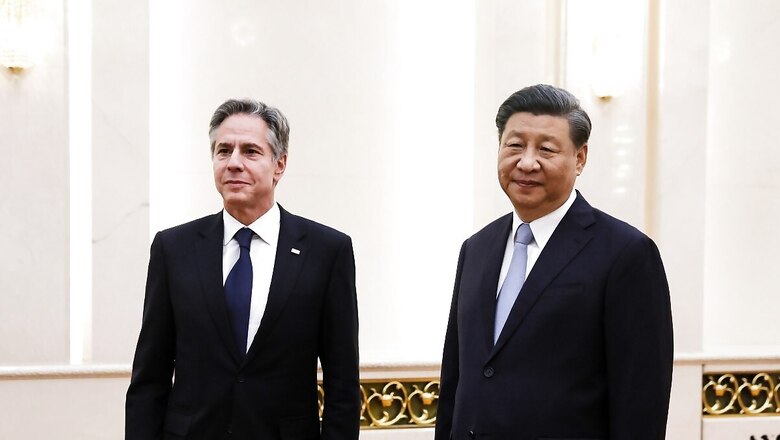
views
China has taken full advantage of globalisation and the framework of the WTO to become a formidable economic colossus, and this in collaboration with the US and its allies. In 30 years, China developed into a global manufacturing hub with a huge inflow of capital and technology from the G7, and a carefully crafted industrial policy supported by state subsidies.
This very rapid industrial expansion resulted in overcapacities in many areas, which China has successfully used to dump products and obtain control of external markets by killing competition. Equally, China, with foresight, and with the huge financial resources at its command, acquired control over many critical raw materials and made advances in many critical technologies vital for a transition to green energy amidst climate change concerns. Solar panels and batteries for electric vehicles are examples. At the same time, China has developed into a strong military, nuclear and space power.
China is now challenging US power. The equations between the two countries have changed. China, as the second largest economy, a huge market and the biggest exporting nation, with its tentacles now spread all over the globe through its Belt and Road Initiative, cannot be either ignored or contained. The US, European and Japanese economies are far too linked with the Chinese economy to risk a rupture.
The US now sees China as its principal adversary and is forging policies that would rebuild its own industrial strength in critical areas in order to reduce dependence on China, as well as to slow down China’s technological progress through denial of the latest Western technologies. It is also putting pressure on Europe to follow suit.
If the US intends to blunt the China challenge, its geopolitical strategies are not in tune with this objective. It is seeking to simultaneously contain both Russia and China, giving both the incentive to support each other, which adds to the challenge the US faces. While the US claims it can handle conflicts both in Europe and Asia and that its proxy war against Russia does not deplete its capacity to thwart China’s expansionism in the western Pacific, the reality is different. The US has already lost ground in West Asia to China as well as Russia. China has played a role in the Iran-Saudi Arabia reconciliation process. Saudi Arabia and the UAE have joined BRICS which has multipolarity as a major objective, as well as promoting trade in national currencies to reduce transactions in US dollars.
On Iran and North Korea, the US is no longer in a position to work with Russia and China cooperatively on nuclear or sanctions issues in the UN or outside. China is supporting Russia politically on the Ukraine issue, including in the UN, and obtaining Russian support on the Taiwan issue. The US is now accusing China of providing dual-use technologies and raw materials to Russia to support its defence production and enabling Russia to prosecute its war against Ukraine.
US Secretary of State Antony Blinken’s visit to China in late April 2024 was in this general background. The goals of the visit had to be limited, given the many points of difference between the two countries. The US is looking for some basic stability in ties even in an atmosphere of mutual distrust. It wants to avoid getting drawn into a military conflict, which is why it has been insisting on US-China military-to-military level talks. Any armed conflict when the presidential election is due later this year would be politically disastrous, although tough political posturing on China would bring electoral benefit.
China too, facing economic headwinds, sees an advantage in engaging in a dialogue with the US to reduce the build-up of pressures on it. Despite its economic and technological achievements, its prosperity depends on access to global markets and advanced Western technologies. It seeks to play for time by calibrating its external posture of a mixture of outreach to the West and a defiant verbal pushback, with some flexing of military muscle in the western Pacific.
According to the Chinese readout of the meeting, Xi used the occasion of Blinken’s call on him to give political lessons to the US, but with standard formulations that give no clue to real thinking and policy. Xi said that China and the US should “be partners rather than rivals; help each other succeed rather than hurt each other; seek common ground and resolve differences rather than engage in vicious competition”. He wanted the US to “honour words with actions rather than say one thing but do another” — which may be true of the US but is equally true of China. Xi proposed “mutual respect, peaceful coexistence and win-win cooperation as the three overarching principles for the relationship”, a meaningless formula China uses for ties even with India.
Xi underlined that the two sides should value peace, prioritise stability, and uphold credibility, though all three are missing in China’s own regional policies and those with India. He talked emptily of building a community with a shared future for mankind, and patronised the US in saying that major countries should behave in a manner befitting their status and act with broad-mindedness and a sense of responsibility. Hinting at a G2, he said that China and the US should undertake responsibilities for world peace, create opportunities for the development of all countries, provide the world with public goods, and play a positive role in promoting global unity.
Stating that China is committed to non-alliance, Xi cautioned against the US creating small blocs — with Quad and AUKUS no doubt in mind. China welcomed a confident, open, prosperous and thriving United States, he said- a condescending tone that shows how much the equation between the two countries has changed.
According to the Chinese read-out, Blinken seems to have used Chinese phraseology to assure China on all points of concern. This was obviously important to the Chinese for internal messaging, as also to counter the US readout which they would expect to underline differences for the US’ own internal messaging and one to its allies. The US did not seek a new Cold War or a change in China’s system, the readout said, or seek to suppress China’s development and revitalise its alliances against Beijing. (This doesn’t sound entirely credible as hindering China’s technological progress and strengthening US alliances in the region are declared US policy objectives.)
Blinken assured China that the US adhered to the one-China policy, wanted to avoid misunderstandings, responsibly manage differences, and had no intention to have a conflict with China. It sought to avoid misunderstandings and miscalculations and achieve stable development of US-China relations. Blinken noted that good progress had been made in their cooperation in such areas as bilateral interactions, counter-narcotics, artificial intelligence and people-to-people exchanges. The multiplicity and complexity of the challenges the world faced required the US and China to work together (seems a Chinese formulation).
The Chinese readout of Foreign Minister Wang Yi’s meeting with Blinken was more explicit about differences. It noted that the overall China-US relations had been stabilised from further deterioration, but negative factors continued to rise and build. Wang Yi stressed that the Taiwan question was the number one red line that must not be crossed in China-US relations. China asked the US to strictly abide by the one-China principle and the three China-US joint communiqués, and not to send any form of wrong signal to “Taiwan independence” separatists. The US needed to act on President Biden’s commitment of not supporting “Taiwan independence,” “two Chinas” or “one China, one Taiwan” and not using Taiwan as a tool to contain China. The US should stop arming Taiwan and support China’s peaceful reunification.
Wang Yi pointed out that no one shall deprive the Chinese people of their right to development. The US had employed all kinds of measures to hit China on trade, economy and technology. This was not fair competition, but steps to contain and block China. It was not de-risking but risk-building. The US said it did not seek to contain China’s economy, decouple or bar China’s progress in science and technology. It should honour those words. The US needed to stop spreading the false narrative of “Chinese overcapacity”, lift illicit sanctions on Chinese businesses and halt the Section 301 tariffs which were against WTO rules.
Wang Yi stressed that in the Asia-Pacific regional countries should not be coerced to take sides, the US should stop deploying land-based medium-range missiles and stop harming China’s strategic security interests.
In the Chinese readout, Blinken noted that the US and China had the most consequential bilateral relationship in the world. (The Chinese don’t want this honour to go to India alone, as the US has been describing the India relationship in these terms). It is important for both sides to responsibly manage this relationship. The US continued to follow its one-China policy and did not support “Taiwan independence.” The US did not seek to change China’s system, had no intention to have conflict with China, and did not seek to decouple from China or hold back China’s development. A growing and successful China was good for the world (doesn’t sound authentic).
On China’s supply of military equipment and dual-use technologies to Russia, an issue Blinken raised quite aggressively before his visit, China’s Foreign Ministry spokesperson had dismissed these “as groundless accusations”, that the normal trade and economic exchanges between China and Russia should not be infringed upon, besides noting the hypocrisy of the US passing a bill providing a large amount of aid for Ukraine. The Chinese government, he said, oversaw the export of dual-use articles in accordance with the laws and regulations (suggesting that it did not need to follow US laws or regulations and that China is not part of the Wassenaar Arrangement)). China, he said, will certainly not accept being the scapegoat, adding that accommodating the legitimate security concerns of all parties and creating a balanced, effective, and sustainable European security architecture through dialogue and negotiation was the only right way forward.
The US read-out of Blinken’s meetings is an omnibus one, covering all his meetings, with no separate readout on his meeting with his counterpart Wang Yi and Xi Jinping. It differs from the Chinese readout, with the US spelling out differences much more prominently. It is interesting that in the US readouts, China is referred to as the PRC, not China. The US emphasis is on “managing competition” with the PRC, not on cooperation, except in select areas such as in counternarcotics to disrupt the flow of synthetic drugs (fentanyl) into the US, enhanced dialogue at a military-to-military level to avoid miscalculation and conflict, responsible and reciprocal policies to facilitate expanded exchanges between students, scholars and businesses, and launching talks on managing the risks of advanced forms of artificial intelligence.
Blinken addressed the PRC’s non-market economic policies and practices that distorted trade and threatened the US’s national security and raised concern about the global economic consequences of the PRC’s industrial overcapacity. Blinken was firm that the US will continue to defend its interests and values, and those of its allies and partners, including preventing advanced US technologies from being used to undermine US national security and economy without unduly limiting trade or investment.
He raised concerns about Hong Kong’s autonomy and democracy and the PRC’s human rights violations in Xinjiang and Tibet, as well as transnational repression. He raised serious concerns about the PRC’s support to Russia’s defence industrial base to prosecute its war against Ukraine and undermining as a result European and transatlantic security. He underscored the importance of maintaining peace and stability across the Taiwan Strait and expressed concern over destabilising PRC actions at the Second Thomas Shoal (China’s confrontation with the Philippines).
That Blinken was not seen off on departure by any Chinese official says something about the outcome of his visit.
Kanwal Sibal is a former Indian Foreign Secretary. He was India’s Ambassador to Turkey, Egypt, France and Russia. Views expressed in the above piece are personal and solely those of the author. They do not necessarily reflect News18’s views.




















Comments
0 comment